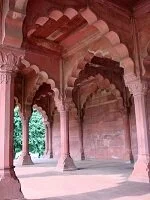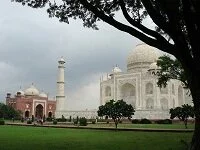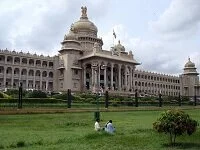
Red Fort in Delhi
Islamic influence arrived to India early, but didn't make any true impact on the country's architecture until the late 1100s. The Muslims build numerous monuments, but these are primarily located in the country's north, where the Islamic population primarily lived.
The greatest early Islamic buildings were built in Delhi, including Qutb Minar, however over time the monuments expanded and developed to form a new architectural style altogether. During this period a number of mosques were also built throughout the north, including many in West Bengal, including the Atala Masjid (1377-1408), many in Ahmadabad, including the Jami Masjid, and many continued to be built in Delhi, including Jama Masjid.
During this same time, numerous Hindu structures continued to be built, again primarily temples. Perhaps the most impressive of these being the city of Hampi (1300-1500s) in the south, which served as one of the last Hindu kingdoms before the Muslims took over the entire region.

Taj Mahal
The Muslims though did eventually take the region under the Mughal rulers, who later proved to be some of the best designers and architects the world has ever seen based upon their jewel, the Taj Mahal.
Before the Taj Mahal though, the Mughals built Humayun's Tomb (late 1500s) in Delhi, Agra Fort (1565-1574), Delhi Fort (1639-1648), and the I'timah-ud-Dawla (or the "mini Taj"; 1628-1658) in Agra. Finally, the Taj Mahal (1632-1649), which was built as a mausoleum for Shan Jahan's wife, Queen Mumtaz Mahal. Most of these great monuments were built under the leadership of either Akbar or Shan Jahan. From the Taj Mahal, which is arguably the finest building ever constructed, the architecture had only one direction to go and that was down; from this point there was a slow decline in monumental architecture in India under the Muslim rulers.
At this same time, in the 1500s and later the Europeans had a strong influence on India's architecture. The Portuguese colonized Goa and the city received numerous European-styled buildings, most particularly in the Baroque style, including the Church of Bom Jesus (1594-1605).

Bangalore's Government Building
During the 1700s and 1800s neo-Classicism was introduced by the British and numerous buildings combined European classical architecture with local styles and tastes. These buildings are best represented with government buildings in large cities, including Calcutta, Delhi, Chennai, Mumbai, Hyderabad, and Bangalore.
Into the modern age, outside influence has continued to alter Indian architecture. Among the oddest of these is the city of Chandigarh, which was primarily designed by a Swiss architect. More standard, every large city now has multiple skyscrapers modeled after or by European and American architects. Some of these modern designs have also been altered to fit the local tastes, such as the Lotus Temple in Delhi.